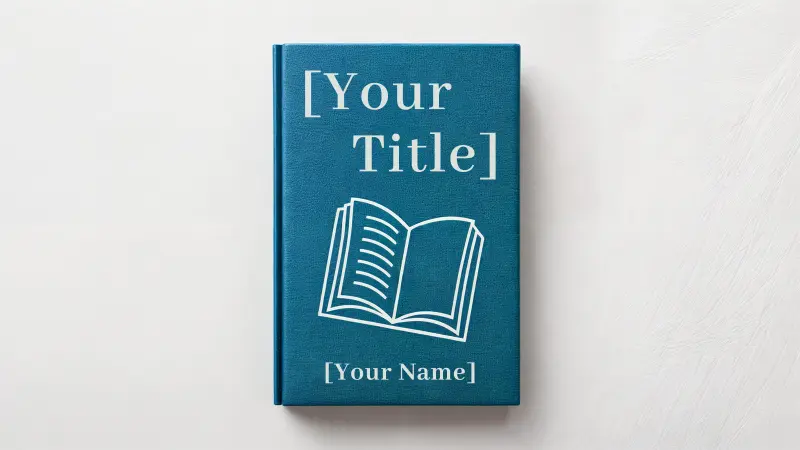“Planning is the foundation that helps transform a spark of an idea into a compelling story.
While some writers thrive on structure, others prefer to dive straight into writing. For instance, Ann Patchett doesn’t play by these rules at all. She’s not a fan of making notes; she prefers to write after figuring things out in her mind.
On the other hand, some writers, like J. K. Rowling and Sophie Hannah, swear by planning.
The beauty of novel planning lies in its flexibility. Whether you’re a meticulous plotter or an adventurous pantser, having some structure can help guide your creative flow without restructuring your imagination.
The best thing about planning is not forgetting anything important about your story or characters. Planning your novel saves time, simplifies things for when you write your actual book, and helps prevent writer’s block by giving you a roadmap to follow when inspiration wanes.
There isn’t a single best way to map out a book, you can plan your novel however you like. This flexibility allows you to experiment with different methods until you find one that works for you.
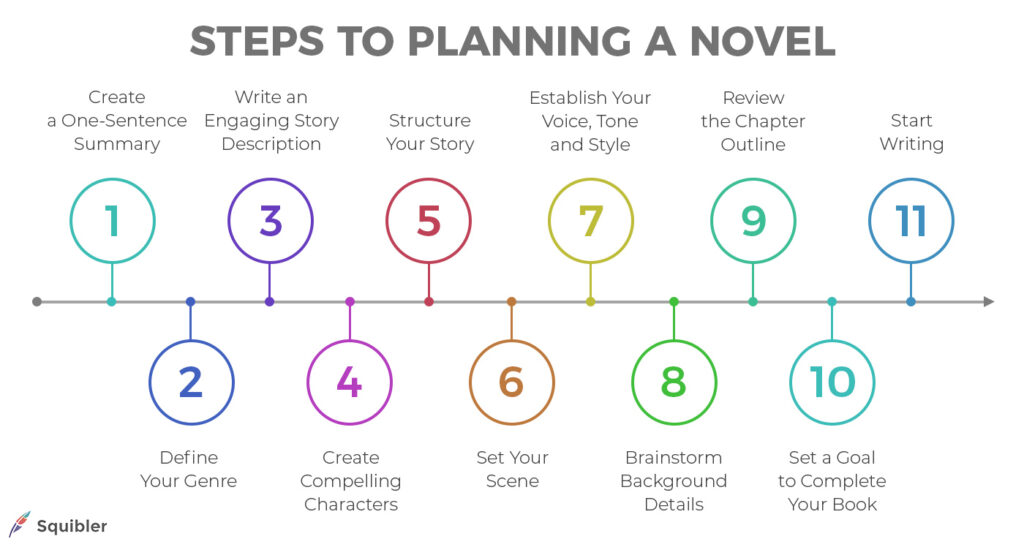
How to Plan a Novel in 11 Steps
If you’re a fiction writer, first-time novelist, or any kind of novel writer struggling to organize your ideas, these steps will help you begin.
Step #1: Create a One-Sentence Summary
The first step is to summarize your story into a single sentence. This is your one-sentence summary, hook, logline, or pitch. You don’t have to mention characters, scenes, themes, or any other specific details, rather write a single line to describe your novel’s idea.
Here is a one-sentence summary of Harper Lee’s To Kill a Mockingbird:
“An attorney who hopelessly strives to prove the innocence of a black man unjustly accused of assault and a mysterious neighbor who saves her and her brother from death.”
Here is another example from J.K. Rowling’s Harry Potter and the Sorcerer’s Stone:
“A young boy discovers he’s a wizard, attends a magical school, and must protect a powerful stone from the evil wizard who killed his parents.”
Here is a summary from Stephen King’s The Shining:
“A struggling writer takes his family to a haunted hotel, where supernatural forces and his own unraveling mind threaten their lives.”
If you’re unsure of the details at this stage, don’t worry. The goal is to capture the essence of your story in its simplest form, keeping in mind that you can refine it as your ideas evolve.
Step #2: Define Your Genre
After creating a one-sentence summary of your novel, the next step is to define its genre. The genre is more than just a label; it shapes the entire structure of your book, from tone and pacing to character development.
Choosing a genre early in the writing process helps you focus your narrative and avoid inconsistencies. Additionally, knowing your genre makes it easier to position your book in the market.
To define your genre, start by analyzing the core elements of your story. Ask yourself: What is the central theme? What kind of emotional response do I want to evoke in readers? If your story revolves around a romantic relationship with a happy ending, it is likely to fall under romance. If it features an epic quest in a magical world, it’s probably fantasy.
You should also consider the main conflict. Is it a murder readers must solve (mystery/thriller), a journey of self-discovery (literary fiction/ self-help nonfiction), or a world-changing catastrophe (science fiction)?
Identifying these elements will help you determine where your book fits.
Another useful approach is to compare your novel to existing books. If your story resembles popular works in a specific genre, chances are it belongs there. You can also start by looking at your target audience and work backward as different genres appeal to distinct reader demographics.
If you want to streamline the novel creation process, you can also generate a custom book template with Squibler’s novel generator.
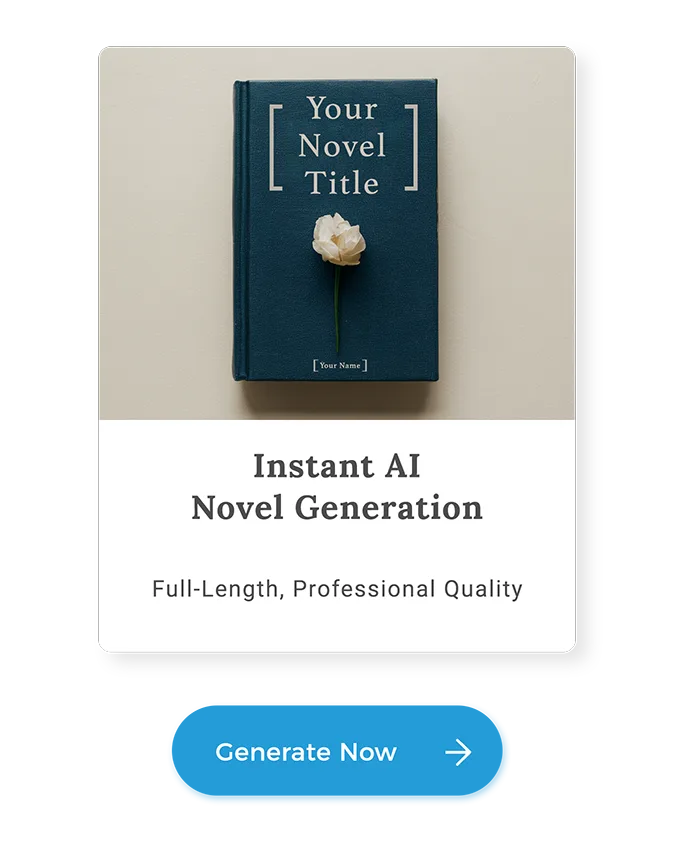
Step #3: Write an Engaging Story Description
A story description is a concise summary of a narrative that highlights the main characters, settings, and central conflicts driving the plot. Often confused with a blurb, which is typically promotional, this description offers a deeper look into the story’s themes and key players, giving readers a more detailed preview of what is to come.
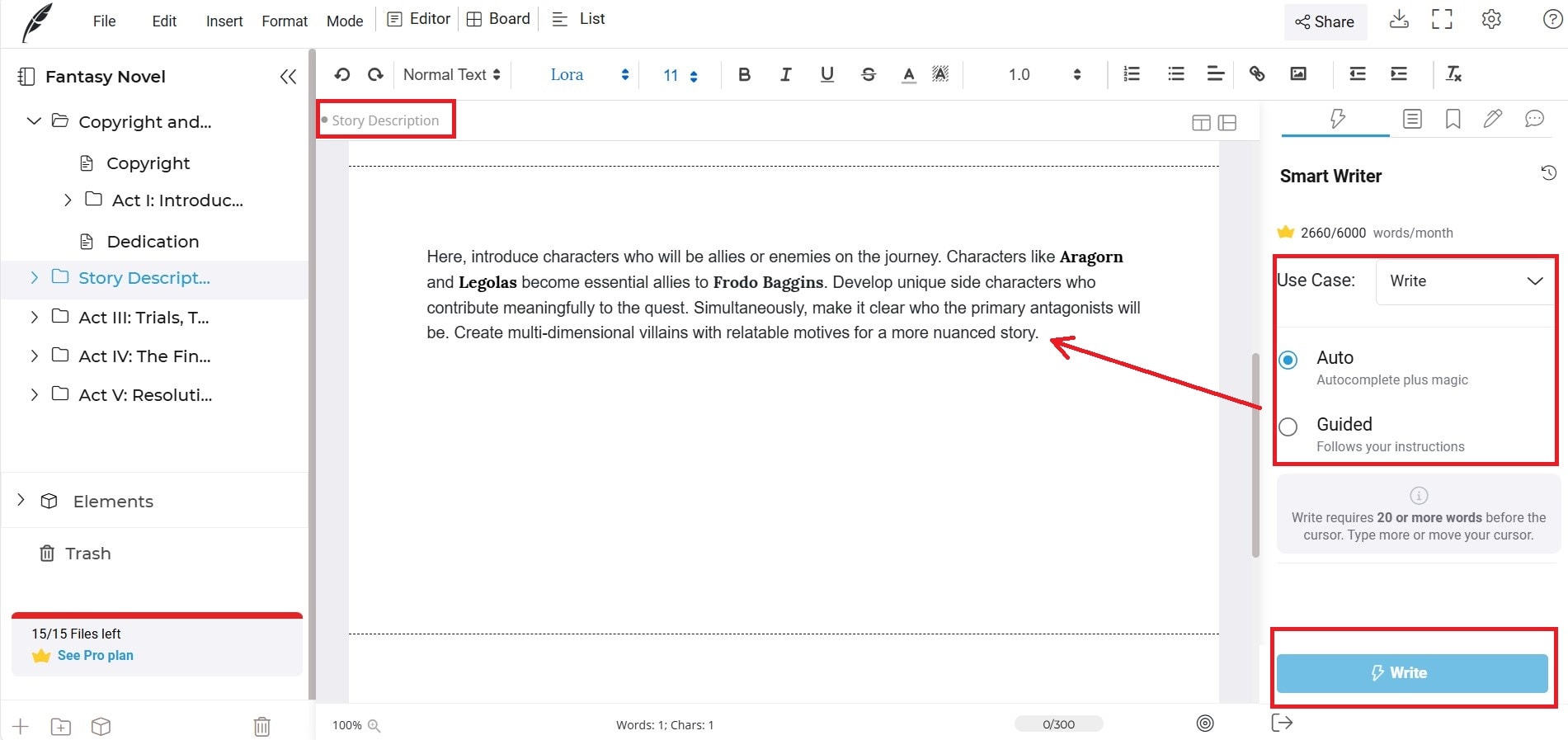
Think of how you would describe your novel to a friend or how you would explain your idea to a colleague. Don’t overthink it. The blurb is like a draft and will go through multiple edits during your writing process.
Here is an example of a short description with a strong opening with great word selection.
“Our heroes, resolute and united, stood at the precipice of their first true trial. An ominous force loomed, promising loss and demanding sacrifice. This was to be a pivotal moment, a test of their mettle, and the outcome would shape their destiny. The enemy revealed itself in a blinding flash of light, an otherworldly creature of immense power. Its very presence struck fear into the hearts of the brave souls who dared to challenge it.”
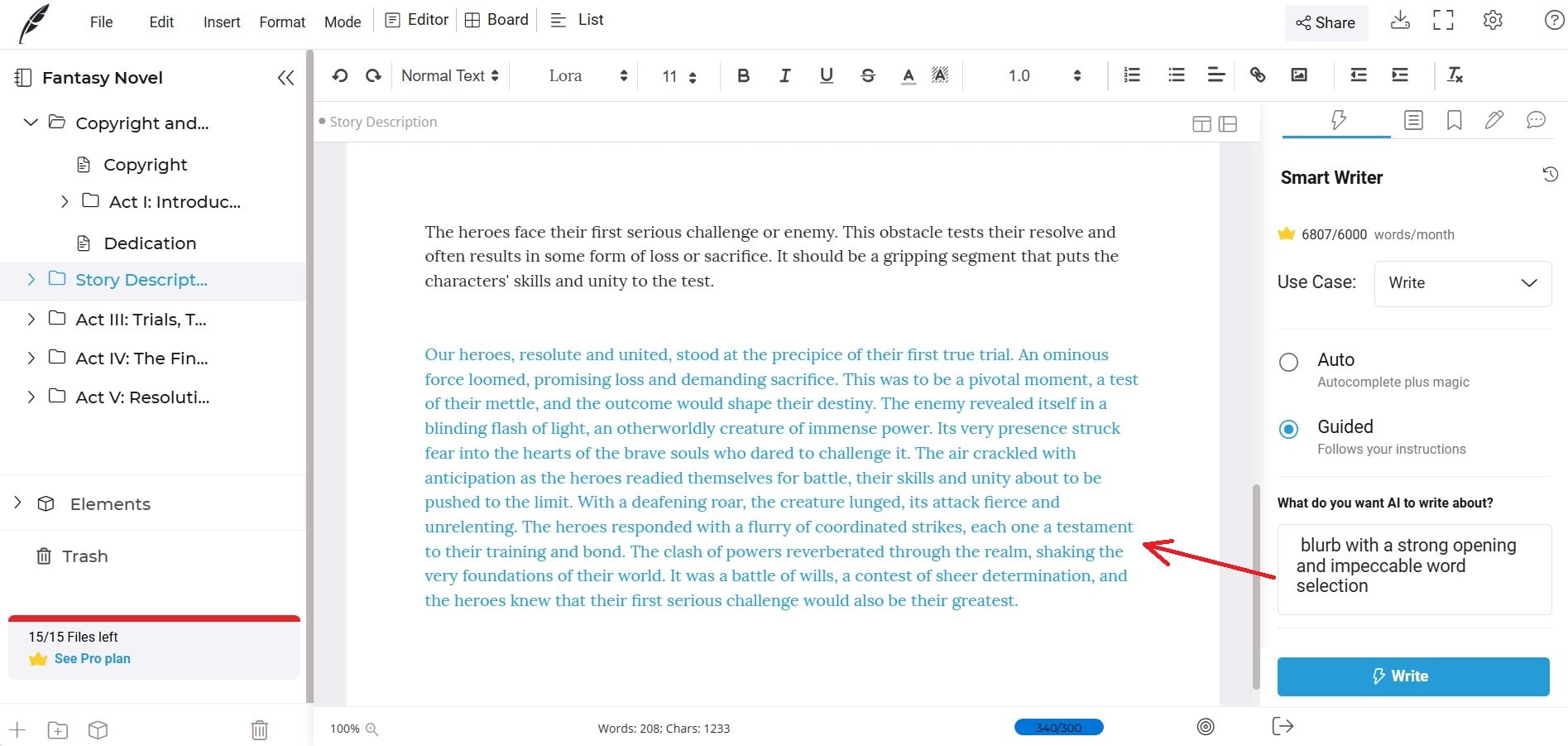
Here are a few things to consider when writing your story description:
Appeal to the senses. Describe scenes, smells, and sounds to create a multi-dimensional experience.
Add a hook (this is a must).
Focus on what matters. Highlight the elements of the settings or characters that contribute to the story’s atmosphere or plot.
Step #4: Create Compelling Characters
Now let’s come up with compelling characters, the soul of your novel. You need to generate character profiles for all the characters in your story. Here is what a character profile includes:
Name
Age
Personality traits
Appearance
Any other necessary details like backstory, goals, and motivations.
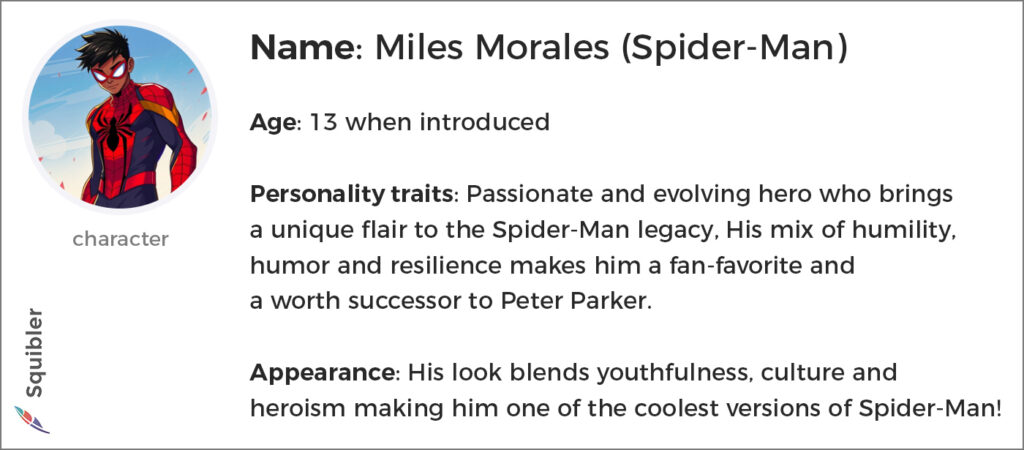
Depending on the novel genre and plot, you might have several types of characters.
Protagonist (Hero)
This is the main character who drives the whole story. The protagonist is the hero or heroine of the novel facing conflict and seeking resolution. Think of Bilbo Baggins in The Hobbit or Miles Morales in the Ultimate Comics series.
Antagonists (Villain)
An antagonist is a villain in your narrative. They oppose your protagonist, by creating tension and driving the plot. Antagonists are equally important as they give meaning to your story and keep readers hooked. Examples include Smaug in The Hobbit and Lord Voldemort in the Harry Potter series.
Power Players
These are the characters who either positively or negatively impact your novel and have the power to change the plot or add a twist. If you have any power players, define them, and build their profiles.
Mentors
A mentor in a novel is a character who guides the protagonist and acts as their mentor. It isn’t necessary to have a mentor but if you have any, develop their profile too.
Minor Characters
Don’t forget about the minor characters. These are the ones who act as supporting characters. There could be several minor characters in your novel depending on the plot and it can help to develop their profiles at this stage to avoid hiccups later on.
Need help creating character profiles? Follow this guide for character development ideas and polishing.
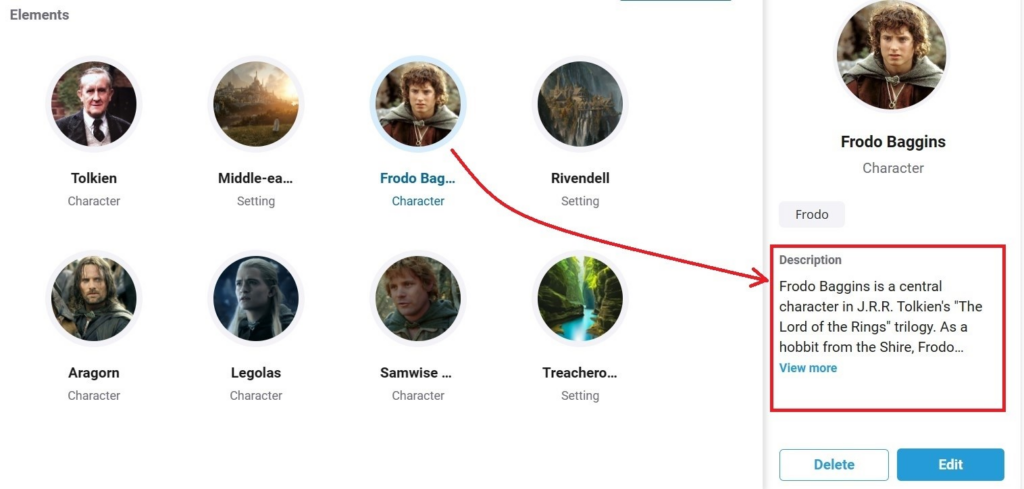
Struggling to come up with character ideas? Squibler’s AI Character Generator takes the guesswork out of character creation.
Step #5: Structure Your Story
The actions and experiences of your characters drive the progression of your novel. While a complete understanding of the plot may not be necessary–since it will naturally develop and evolve–you should have a foundational structure in mind. It is essential to articulate this framework to ensure a cohesive narrative.
There are several structures used to craft a novel plot including the three-act structure, five-act structure, and Freytag’s Pyramid. Here is how Freytag’s Pyramid works:
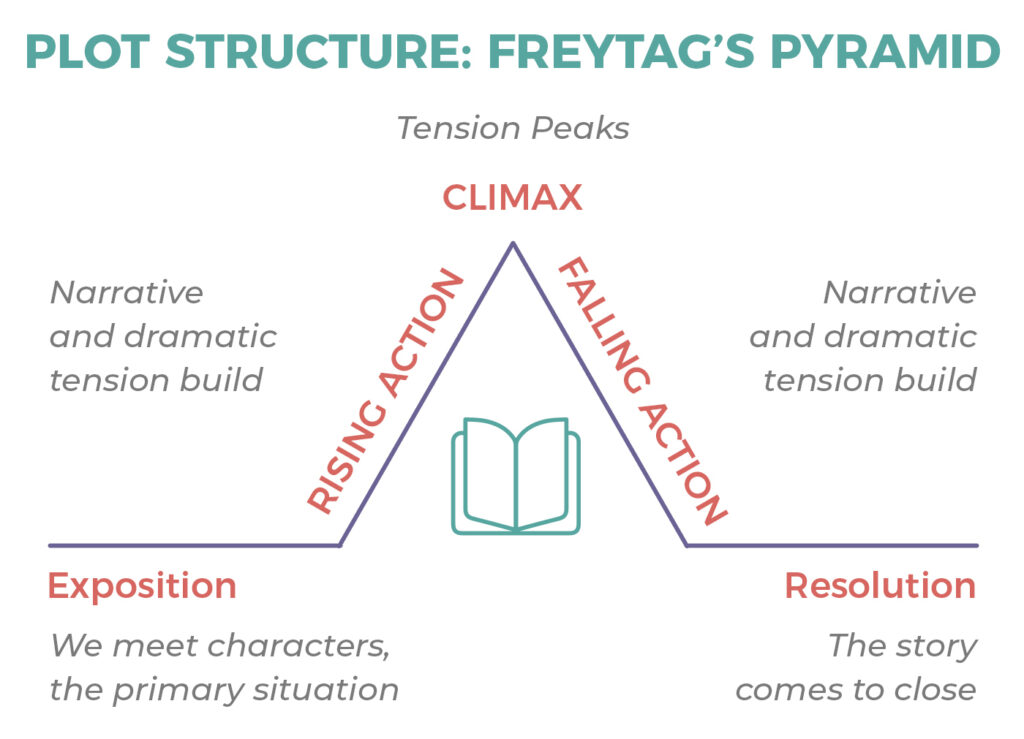
For example, in J.R.R Tolkien’s The Lord of the Rings, the rising action includes Frodo’s journey with the Ring, the climax is the confrontation at Mount Doom, and the falling action deals with the aftermath in the Shire.
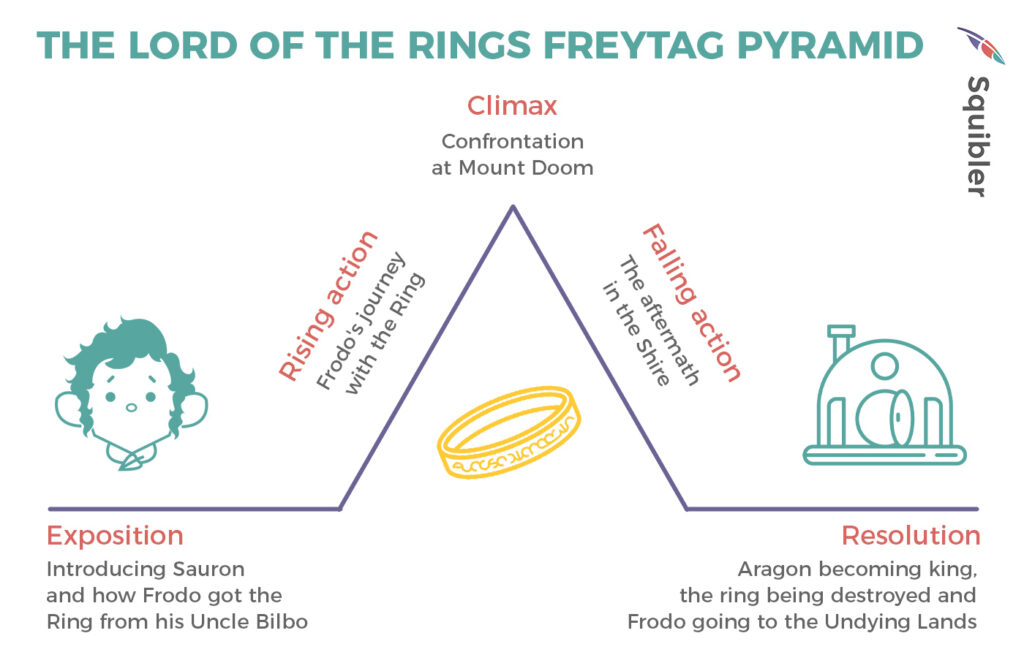
In a simpler form, your plot must consist of the following:
Conflict
Twist
Climax via increasing tension
Resolution of the conflict
Ending
Here is a simple way to plan your story’s plot:
Plan the middle part first as it is easiest. You have to create conflict, tension, twist, climax, and move towards the resolution. There is a lot of scope in the middle part of the novel so it is best to plan its plot first with detailed specifications
Figure out the ending of the story. The novel must end with conflict resolution
Plan the beginning. It is usually hard to write or even plan the beginning. You can skip it for now if you have no idea where and how to begin the novel and how to write a catchy introduction that will keep readers hooked.

When planning your novel’s plot, consider whether it will be part of a series or a standalone book.
If you’re creating a standalone novel, you’ll want to ensure the ending feels complete and satisfies your readers. This means typing up key storylines and resolving major conflicts. However, if you’re planning a series, you can leave room for future development.
If you want inspiration, you can use Squibler’s plot generator which comes with 500+ short story ideas that will do all the heavy lifting for you.
Step #6: Set Your Scenes
The setting defines the when and where of your novel. Planning your setting involves identifying key elements such as location, environment, objects, atmosphere, and time period.
The place and time in the novel play a significant role in how readers perceive it. For example, consider how these settings shape the reader’s experience:
A couple sitting on a quiet beach at sunset.
A teenager standing on the edge of a skyscraper, contemplating whether they should jump.
These two settings create entirely different tones and emotional impacts.
Similarly, the period affects readability and immersion. A novel set in 17th-century France will have a different language style, societal norms, and character behavior than one set in the year 2225 dystopian city.
If your novel involves worldbuilding, like creating a fictional realm, expect to invest a lot of time crafting unique settings, histories, and cultures. Many fantasy and science fiction authors develop maps, political systems, and even languages to make their world feel real–think of George R.R. Martin’s continent – Westeros, or Frank Herbert’s Dune universe.
Here are a few writing tips to plan the setting for your novel:
Figure out the place where the lead characters spend most of their time.
Plan for the location, climate, environment, geography, technology, and time in your world.
Plan the farthest place your main character can go.
Ensure that the setting supports the plot.
Think about how the setting influences character choices and plot development.
Step #7: Establish Your Voice, Tone and Style
Your authorial voice is what makes your writing unique. Style is broader and adaptable. Voice reflects your personality, character, and background, whereas style is the way you express that voice on paper. Some writers have a straightforward writing style with simple language, while others embrace sarcasm, lyricism, or elaborate prose.
The way you write the novel brings it to life, making it distinct from others in the genre. However, while your voice remains constant, you can adjust your writing style to fit the conventions and expectations of your chosen genre.
A great guide that explores writing style is The Elements of Style by William Strunk Jr. and E.B. White. Some of the important points include:
Omit needless words.
Concise writing is powerful so avoid unnecessary words or redundant phrases that don’t add meaning. Instead of “In order to” say “To,” and replace “Due to the fact that” with “Because.”
Use active voice.
Writing in an active voice makes sentences clearer and more engaging. Instead of “The book was read by Sarah,” say “Sarah read the book.”
Use definite, specific, and concrete language.
Vague and abstract words weaken writing. Instead of saying “He was very happy,” describe the feeling by saying “He grinned and his eyes sparkled.” Specific details create a stronger impact.
Structure sentences for accuracy.
Word order matters in conveying the right meaning. Compare “She only told me the truth” (which suggests she didn’t do anything else) with “She told me only the truth” (which clarifies that she said nothing but the truth). The placement of only in the first sentence focuses on the action of telling, while the second, focuses on the information.
Adapting your style does not mean you need to abandon what makes you unique. Finding the right balance will help your story resonate with readers.
The way you write science fiction will be much different than how you write crime novels. Point of view (POV) is another important variable. First-person POV creates an intimate, personal experience by allowing the reader to see the world through the protagonist’s eyes. Second-person POV directly addresses the reader using “you” and “your” and is common in nonfiction books. Third person POV, the most popular in fiction, is narrated from an external perspective using pronouns like “he”, “she”, and “they”.
Writers tend to choose a POV that best suits their storytelling style, with first-person offering a strong sense of immediacy, second-person creating direct engagement, and third-person providing flexibility and depth.
Your target audience also impacts your voice and style. If you are writing a romantic novel targeting teens, you’ll use different language and a soft style as opposed to writing a romance novel for adults.
You need to figure out your story’s voice and style early on. Before starting your novel, experiment with different styles and perspectives to see what works best.
Step #8: Brainstorm Background Details
At this stage, gather all the research, notes, and character backstories you’ve developed so far. Plan and organize all the details so that you don’t forget it. This information can come in handy as a reference.
Here is an example of how to chart the background details.
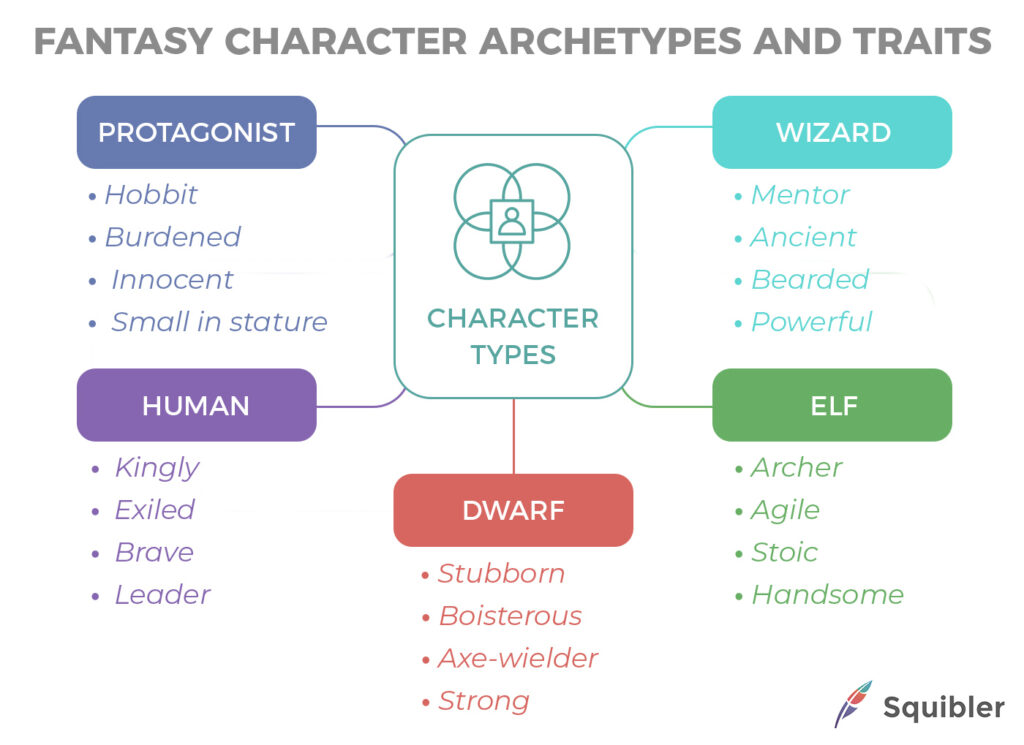
The more details you outline now, the easier it will be to maintain consistency in your writing.
Step #9: Review the Chapter Outline
Now you have a firm grasp on the setting and plot, and all the characters, it’s time to create a chapter-by-chapter outline. An outline helps ensure a logical progression of events, identify gaps or weak points in the narrative, and prevent writer’s block by giving you a roadmap.
To structure your outline:
Decide how many chapters your novel will have.
Give each chapter a working title.
Write a brief description of the events of each chapter such as conflict, climax, twist, etc.
Decide the point of view for each chapter and important scene in the novel.
Check the timeline and ensure that all the scenes, actions, and chapters are chronologically arranged.
Make sure every chapter contributes to the overarching plot.
Breaking down your plot into chapters lets you know exactly what to write in each chapter. Below is an example of a chapter outline from Squibler. By providing it with a prompt, Squibler will generate a complete outline, which you can then map to your story and modify as needed.
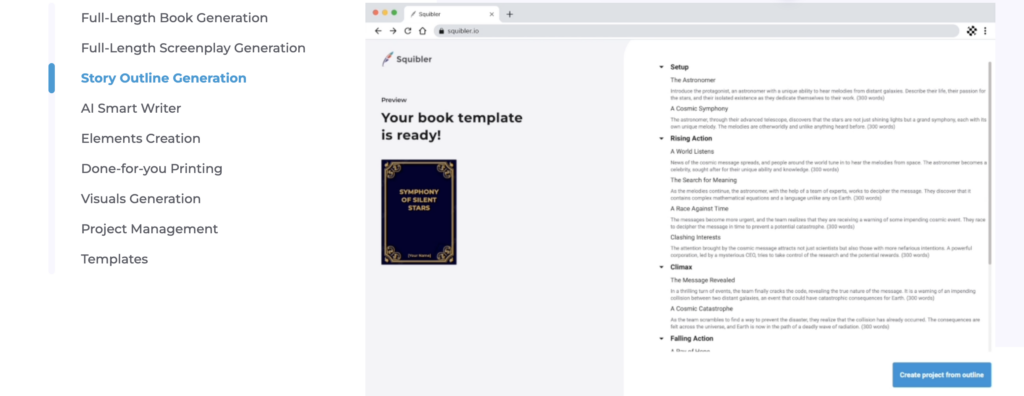
If you don’t have a lot of details about the plot and chapter details, it is the best time to plan it out. If your novel is part of a series, this is where you decide how the first book’s ending will set up the next installment.
Step #10: Set a Goal to Complete Your Book
When do you plan to complete this novel? Do you have a turnaround time in mind?
One of the key aspects of planning a novel is to think about how and when you’ll start and finish the novel. Planning a novel isn’t the same as writing a novel. Having a plan is great, but without a deadline, it’s easy to procrastinate.
To avoid delays, you need to create a step-by-step action plan on when you’ll finish writing. When setting completion goals:
Decide on a deadline for completing your first draft
Break your goals down into smaller milestones (for example, “finish chapter 5 by next weekend”).
Use productivity tools to stay on schedule (like
)
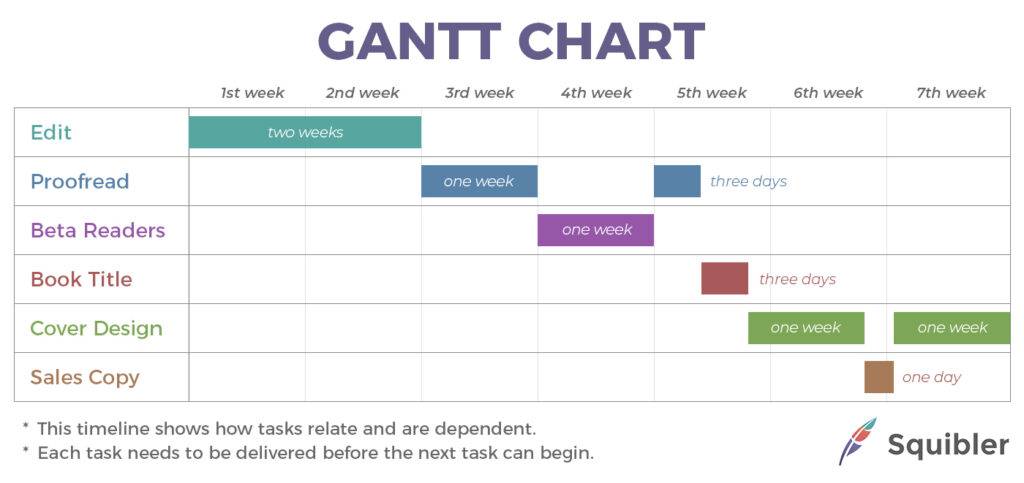
Squibler also has a great project management tool that allows you to keep track of your progress, from its status, to target words per chapter, and it even allows you to set priorities and assign collaborators.
Step #11: Start Writing
Now that you have a plan, it’s time to begin writing your first draft.
While planning doesn’t guarantee that you’ll start and finish your novel, one of the main reasons why novelists don’t finish their novels is because they don’t have a plan.
A solid plan provides direction and motivation, making writing more manageable. However, planning is not mandatory–some writers thrive on spontaneity–but if you struggle with writer’s block or maintaining structure, having a roadmap can be a game changer.
Remember, your first draft does not have to be perfect. Many great novels went through multiple revisions, so don’t get stuck trying to make everything flawless from the start. What matters most is that you begin.
Consistency is key–writing a little every day is more effective than waiting for inspiration to strike. Even if progress feels slow, each word gets you closer to a finished book.
To stay organized and motivated, consider using novel-writing software like Squibler’s, which helps with chapter structuring, character tracking, and progress monitoring. But whether it’s software or a simple notebook, find a method that keeps you accountable.
By following this 11-step guide, you now have a helpful starting point to bring your novel to life. There is no single “correct” way or specific rules to plan a book–experiment to find what works best for you. The important step is to start writing. Your novel won’t write itself, so begin–one word at a time.
FAQs
Here are some commonly asked questions about planning a novel:
How do you start planning a novel?
To start planning a novel, begin with a basic concept and use writing prompts to spark your creativity. Determine the genre, such as historical fiction, and outline the main plot points. Develop your characters and setting to build a solid foundation. Embrace the writing journey by focusing on creating your first draft, allowing your story to evolve as you go.
How to write a novel step by step?
To write your first novel, start with a rough idea and outline the main plot. Create vivid characters that drive the story. Write a few pages each day to build momentum. If you’re writing crime fiction, focus on developing a compelling key scene that hooks readers. Gradually expand your narrative, ensuring each chapter builds on the last until your story is complete.
How do I start my first novel?
To start your first novel, begin with a clear idea for your story and lead characters. Outline the plot to provide direction and structure for your fiction writing. Set a writing schedule to maintain consistency, and write a little each day to build momentum. Embrace the process and allow yourself to explore and refine your story as you go.
Is 50,000 words enough for a novel?
The word count of a novel varies and depends on everything from the genre to the audience and the author’s experience. 50,000 words is approximately 100 pages and 3.2 hours of reading time. It is recommended to aim between 80,000 to 100,000 words for a first-time novel.
